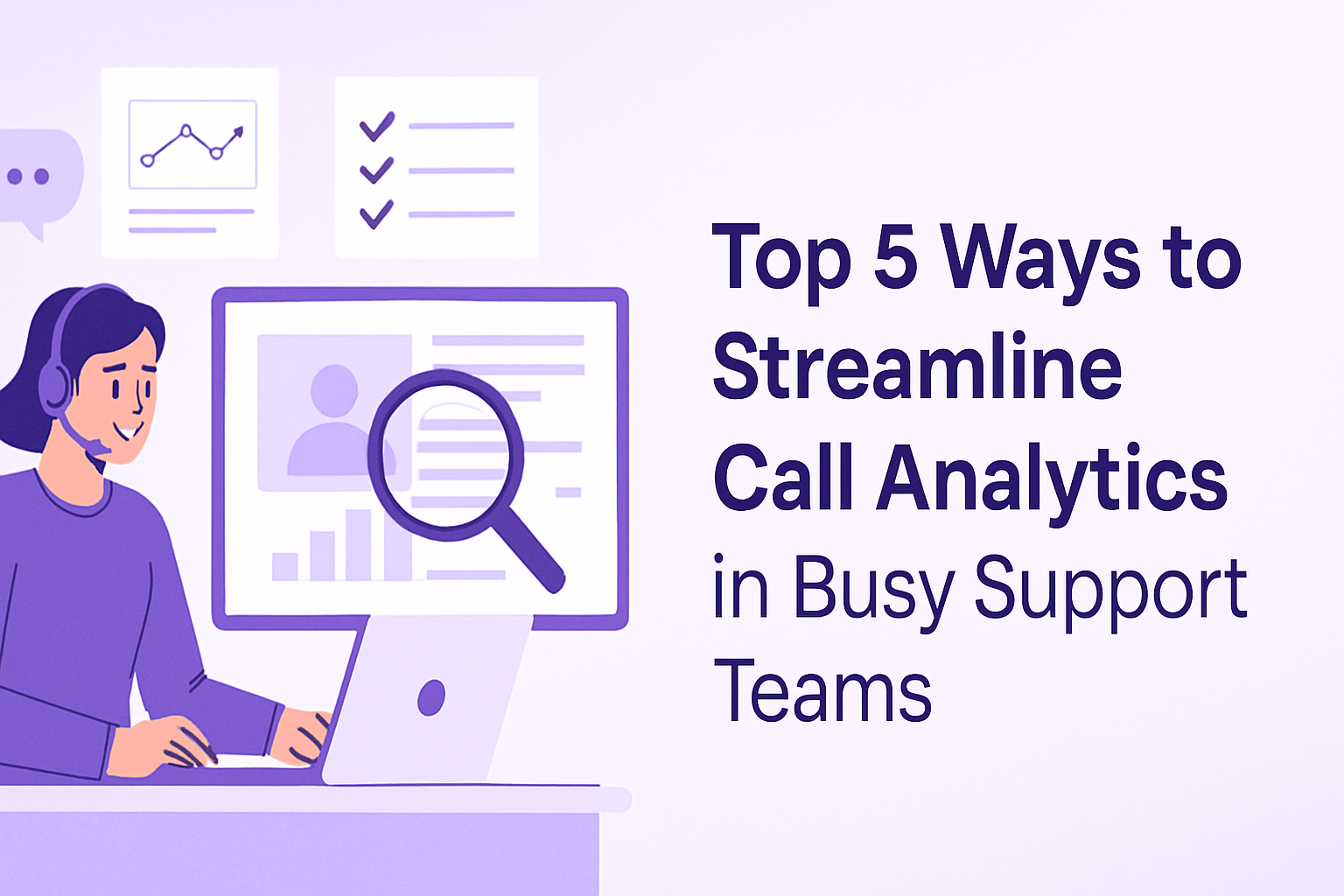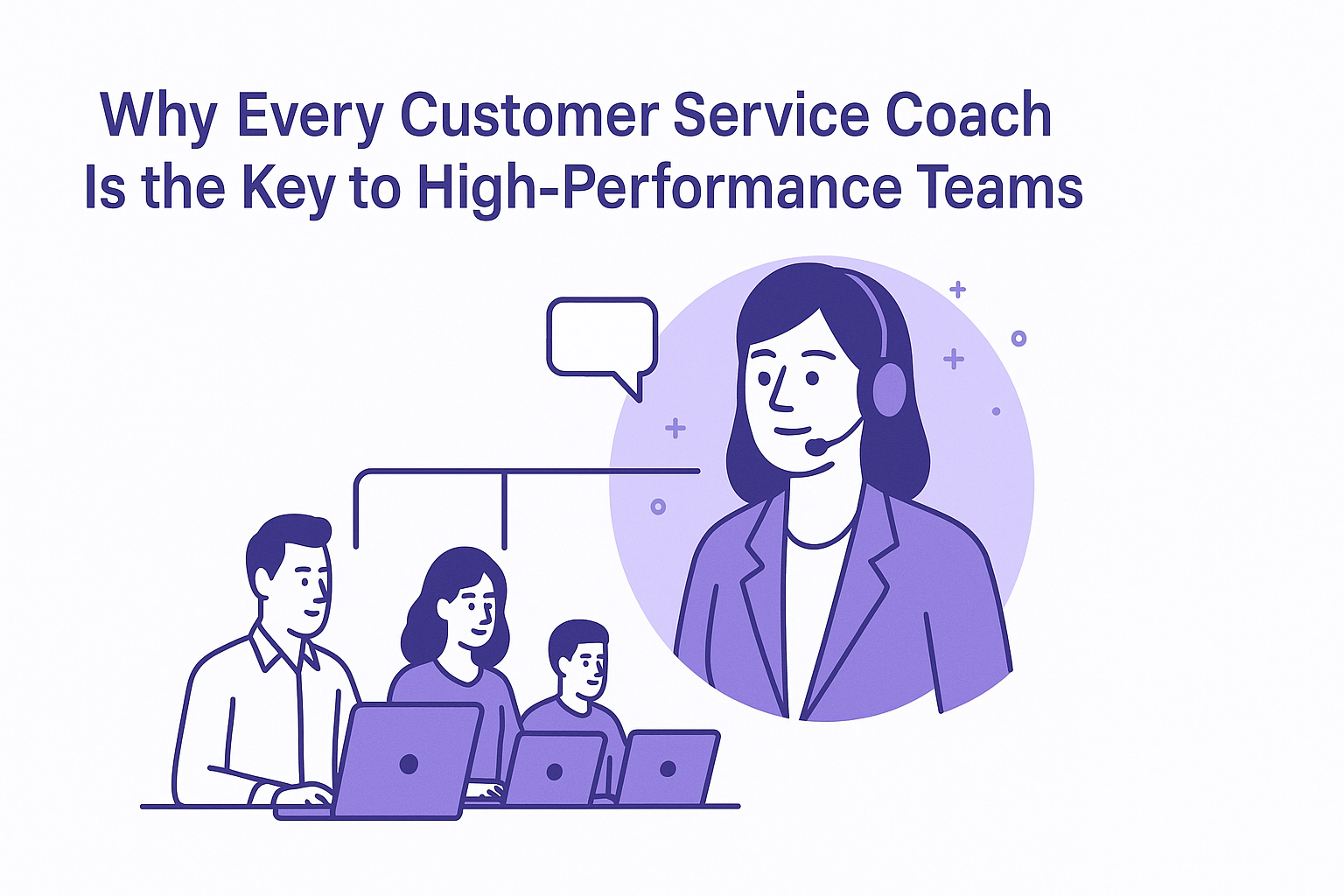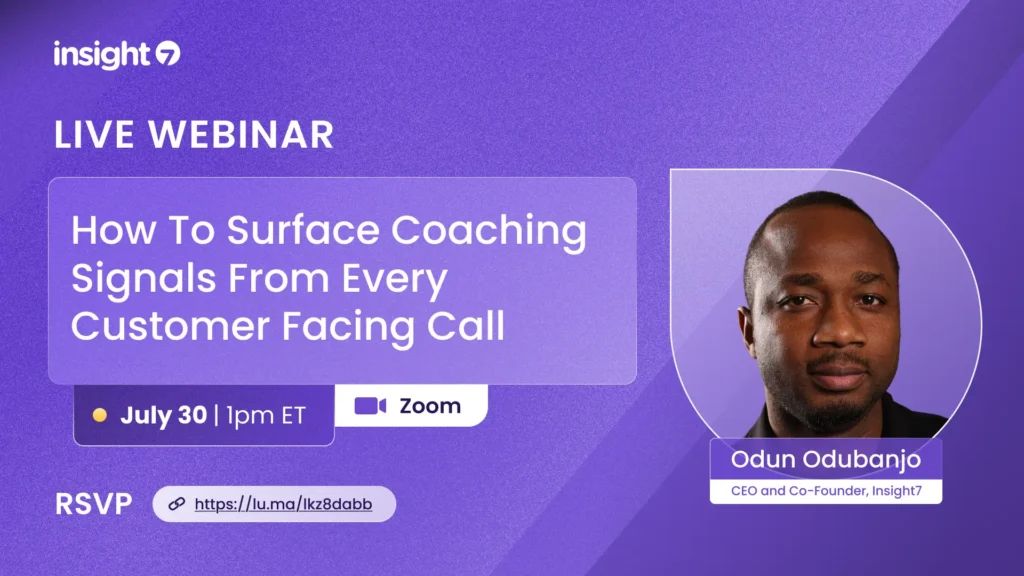Top 5 Integration Workflows for AI Call Analytics in Large Enterprises
-
Hello Insight
- 10 min read
Top 5 Integration Workflows for AI Call Analytics in Large Enterprises
In today's fast-paced business environment, large enterprises are increasingly leveraging AI call analytics to enhance customer interactions, streamline operations, and drive data-driven decision-making. This guide will explore the top five integration workflows that can significantly improve the efficiency of AI call analytics, helping organizations turn customer feedback into actionable insights. By implementing these workflows, enterprises can not only optimize their product and go-to-market strategies but also ensure they remain competitive in a data-centric world.
The Role of AI Call Analytics in Modern Enterprises
AI call analytics has become crucial for large organizations striving to improve customer experiences and operational efficiencies. By effectively analyzing customer interactions, companies can identify key themes, operational blind spots, and opportunities for growth. This approach shifts businesses from reactive to proactive management, enabling them to preemptively address customer concerns and refine their services.
To harness the power of AI call analytics effectively, organizations need to integrate data from various sources, including call recordings, CRM systems like Salesforce and Hubspot, and team communication tools like Slack and Gong. Proper integration aligns different functions across the enterprise, ensuring that insights derived from customer interactions inform decisions at every level.
What is AI Call Analytics?
AI call analytics refers to the use of artificial intelligence to analyze and extract insights from customer interactions over the phone. Unlike traditional methods that often rely on manual review and interpretation, AI call analytics automates the analysis process, providing real-time insights into customer sentiments, call outcomes, and agent performance.
Core Capabilities:
- Sentiment Analysis: Understanding customer emotions during calls to tailor responses and improve satisfaction.
- Performance Scoring: Evaluating agent interactions based on predefined criteria, identifying coaching opportunities.
- Keyword Tracking: Monitoring specific phrases or terms to understand customer needs and concerns.
- Trend Identification: Spotting recurring issues or themes across multiple calls to inform product development and marketing strategies.
- Automated Reporting: Generating insightful reports without the need for manual input, saving time and resources.
Strategic Value: This enables proactive decision-making that enhances customer experience and aligns product offerings with market demands.
Why Are Consultants and Insight-Seeking Professionals Investing in AI Call Analytics?
Context Setting: Organizations are transitioning from outdated methods of customer interaction analysis to more advanced, AI-driven approaches to keep pace with changing consumer expectations.
Key Drivers:
- Increased Customer Expectations: Traditional methods often fail to capture the nuances of customer sentiment, leading to missed opportunities for improvement.
- Speed and Efficiency: AI-driven analytics processes provide results in real-time, allowing for quicker decision-making and implementation of changes.
- Personalization: Enhanced analysis capabilities enable businesses to tailor their offerings based on individual customer preferences, improving engagement.
- Operational Optimization: AI allows for a more streamlined process, reducing the time spent on manual analysis and improving overall efficiency.
What Data Powers AI Call Analytics?
Foundation Statement: A robust AI call analytics system requires diverse data sources to build reliable models that enhance insight accuracy and relevance.
Data Sources:
- Call Recordings: Rich, unstructured data that provides direct insights into customer interactions.
- CRM Data: Information from systems like Salesforce that offer context about customer history and preferences.
- Communication Platforms: Data from tools like Slack and Gong that facilitate team discussions and feedback.
- Customer Feedback Surveys: Structured data that helps correlate call analytics with explicit customer sentiments.
- Social Media Insights: Listening to what customers say online can provide additional context to call data.
Accuracy Benefit: This multi-modal approach ensures that insights are comprehensive, leading to more effective decision-making.
Key Components of an AI Call Analytics Stack
Stack Overview: A successful AI call analytics system is built upon several critical components that work together to process and analyze customer interaction data.
Component Descriptions:
- Data Ingestion Module: Collects and integrates data from various sources, ensuring comprehensive analysis.
- AI Processing Engine: Applies machine learning algorithms to analyze call data, identifying patterns and generating insights.
- Analytical Dashboard: Visualizes data and insights in a user-friendly interface, allowing stakeholders to monitor performance metrics easily.
- Feedback Loop Mechanism: Incorporates ongoing insights into training materials and operational strategies, ensuring continuous improvement.
- Reporting Tool: Automates the generation of reports, facilitating data-driven discussions across departments.
Quality Emphasis: The effectiveness of the AI call analytics stack hinges on the quality of input signals and the interpretability of the results.
How Does AI Call Analytics Work Step by Step?
Step 1: Data Collection
Data is gathered from multiple sources, including call recordings, CRM platforms, and communication tools.
Step 2: Data Processing
The AI processing engine applies natural language processing (NLP) and machine learning algorithms to convert raw audio data into structured insights.
Step 3: Insight Generation
Patterns are identified through analysis, focusing on aspects such as sentiment, performance scoring, and keyword occurrences.
- Sentiment Patterns: Identifying emotional tones in customer interactions.
- Performance Metrics: Evaluating agent performance against set criteria.
- Trending Issues: Recognizing common concerns raised by customers.
Step 4: Training and Learning
Historical data is utilized to refine algorithms and improve the system's predictive capabilities over time.
Step 5: Real-Time Processing
Insights are generated in real-time, allowing for immediate action and intervention where necessary.
Step 6: Insight Delivery
The results are presented through dashboards and reports, enabling stakeholders to make informed decisions.
- Dashboard Overview: Real-time metrics and performance scores.
- Actionable Reports: Specific recommendations based on call analytics.
- Coaching Insights: Feedback for agents on improving interaction quality.
Where Can Consultants Apply AI Call Analytics?
Use Case 1: Enhancing Customer Service
- Prediction Method: Analyzing sentiment trends to anticipate customer needs.
- Recommended Action: Tailoring service approaches based on identified sentiments.
Use Case 2: Improving Sales Performance
- Analysis Approach: Scoring sales calls based on predefined success criteria.
- Follow-Up Action: Providing targeted coaching to underperforming agents.
Use Case 3: Identifying Training Needs
- Identification Method: Analyzing call transcripts to find recurring agent mistakes.
- Proactive Scheduling: Scheduling training sessions focused on common issues.
Use Case 4: Optimizing Product Development
- Forecasting Approach: Using call themes to inform product feature enhancements.
- Optimization Action: Aligning product roadmaps with customer feedback.
What Tools Can You Use for AI Call Analytics?
Investing in the right tools is essential for maximizing the benefits of AI call analytics. Look for platforms that offer robust integration capabilities with existing systems.
Comparison Table:
| Feature | Insight7 | Traditional Alternative |
|---|---|---|
| Real-time Data Processing | Yes | Limited |
| Multi-source Integration | Yes | Manual |
| Sentiment Analysis | Advanced | Basic |
| Custom Reporting | Automated | Manual |
| User-Friendly Dashboard | Yes | Complex |
Common Pitfalls in AI Call Analytics Implementation
Context Warning: Many organizations struggle with AI call analytics due to poor implementation strategies.
Major Pitfalls:
- Inadequate Data Integration: Failing to consolidate data from various sources can lead to incomplete insights.
- Lack of Stakeholder Alignment: Without buy-in from key stakeholders, implementations may lack direction and support.
- Neglecting Quality Control: Overlooking the importance of data quality can skew results and lead to faulty conclusions.
Success Foundation: Avoiding these pitfalls requires a well-thought-out strategy that prioritizes data integration and stakeholder collaboration.
How Do You Get Started with Insight7?
Step 1: Integration Setup
Begin by integrating Insight7 with existing platforms such as Zoom, Salesforce, and Hubspot.
Step 2: Data Synchronization
Ensure that call data is synchronized across all platforms for holistic analysis.
Step 3: Configuration Options
Customize evaluation criteria according to business needs and objectives.
Step 4: Historical Data Training
Utilize existing call data to train the AI models for improved accuracy.
Step 5: Customization for Stakeholders
Tailor dashboards and reports to meet the needs of different teams within the organization.
Step 6: Ongoing Optimization
Regularly review and refine the analytics process to adapt to changing business environments.
What Is The Best AI Call Analytics Setup?
ROI Optimization: Ensuring maximum return on investment starts with a thoughtful setup of the AI call analytics system.
Best Practices:
- Diverse Data Sources: Incorporate various data types to enrich analytics.
- Stakeholder Engagement: Involve key stakeholders in the setup process to ensure alignment.
- Historical Insight Integration: Leverage past data trends for better predictive analytics.
- Regular Review Cycles: Establish consistent review periods to assess effectiveness.
- Automation: Integrate automation to streamline reporting and insights generation.
Building an AI Call Analytics Strategy That Scales
A scalable AI call analytics strategy requires collaboration among various departments. Different teams must align on objectives, ensuring that insights drive actionable outcomes. By prioritizing diverse data inputs and continuous refinement, organizations can develop a robust system that evolves with customer needs.
AI Call Analytics Benchmarks and Success Metrics
Evaluation Framework: Clear benchmarks are essential for measuring the impact of AI call analytics initiatives.
Core Metrics:
- Customer Satisfaction Score: Measures the overall satisfaction level of customers post-interaction.
- Agent Performance Score: Evaluates individual agent performance based on call analytics.
- Call Resolution Rate: Tracks the percentage of customer issues resolved during the first call.
- Sentiment Analysis Accuracy: Assesses the precision of sentiment analysis findings.
- Training Effectiveness: Measures improvements in agent performance following targeted training.
Universal Principle: The ultimate goal of AI call analytics is to drive better business decisions and actions, resulting in enhanced customer satisfaction and operational efficiency.
Frequently Asked Questions
Q: What is AI call analytics?
A: AI call analytics employs artificial intelligence to analyze customer interactions, providing insights into sentiment, performance, and operational improvements.
Q: How does it differ from traditional methods?
A: Traditional methods often rely on manual analysis, whereas AI call analytics automates the process, enabling real-time insights and proactive decision-making.
Q: What platforms can I integrate with?
A: Insight7 supports integration with popular platforms such as Zoom, Salesforce, Hubspot, and Slack.
Q: What data is required for optimal results?
A: Ideal data sources include call recordings, CRM data, communication tools, and customer feedback surveys.
Q: How long does implementation take?
A: Implementation speed varies based on existing infrastructure but typically ranges from a few weeks to a couple of months.
Q: What security measures are in place?
A: Insight7 adheres to stringent security protocols and compliance standards to protect sensitive customer data.






